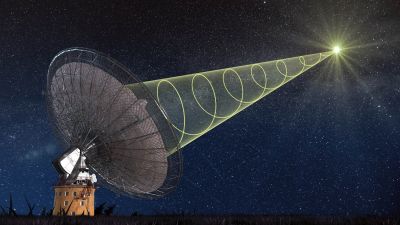Cosmic Radio Burst Caught Red-Handed
19 Jan 2015

A schematic illustration of CSIRO’s Parkes radio telescope receiving the polarised signal from the new ‘fast radio burst’. Credit: Swinburne Astronomy Productions
A team of astronomers using twelve telescopes from around the world, and in space, have for the first time captured a ‘fast radio burst’ happening live.
The achievement will help scientists trap more bursts in the future, which could offer insight into the evolution of the universe. University of Manchester academics working from Jodrell Bank were members of the team, led by Emily Petroff from the Swinburne University of Technology in Melbourne, Australia, that captured the burst using the Parkes radio telescope located in eastern Australia.
Fast radio bursts are short, sharp flashes of radio waves from an as yet unknown source. It is not known what causes them but one possibility is they are from a dying star. This finding brings us a step closer to understanding the phenomenon, which astronomers worldwide are vying to explain. The finding is published today in a paper in Monthly Notices of the Royal Astronomical Society.
Lasting only milliseconds, the first such radio burst was discovered in 2007 by astronomers combing the Parkes data archive for unrelated objects. Six more bursts, apparently from outside our Galaxy, have now been found with Parkes and a seventh with the Arecibo telescope in Puerto Rico.
Professor Ben Stappers, from the University of Manchester, said: “Capturing this burst of radio waves in close to real time is important because it is one of the best ways we can pinpoint exactly where they come from. The rapid identification allows observations at other wavelengths where the phenomena may last longer and thus enable a more accurate location to be determined and thus a possible host galaxy. “
“Fast Radio Bursts were controversial when they were first discovered and it is only in the last few years that their existence has been more widely acknowledged. There are likely to be dozens of them hitting earth every day and if we know their locations and distances they can be used as beacons to study the material between the galaxies, a key element in understanding the make up of the Universe.”
Emily Petroff , who is also part of the ARC Centre of Excellence for All-sky Astrophysics (CAASTRO), said: “These bursts were generally discovered weeks or months or even more than a decade after they happened! We’re the first to catch one in real time”.
Banking that she’d spot a ‘live’ burst, Petroff had an international team poised to make rapid follow-up observations, at wavelengths from radio to X-rays.
After Parkes saw the burst go off the team swung into action on twelve telescopes around the world—in Australia, California, the Canary Islands, Chile, Germany, Hawai’i, and India—and in space.
No optical, infrared, ultraviolet or X-ray counterpart showed up. “That in itself rules out some possible candidates, such as long gamma-ray bursts and nearby supernovae,” said team member Dr Mansi Kasliwal of the Carnegie Institution in Pasadena, California.
But short or low-energy gamma-ray bursts and giant flares from distant magnetars (the most magnetic stars in the Universe) are still contenders, she added. So too are imploding neutron stars.
One of the big unknowns of fast radio bursts is their distances. The characteristics of the radio signal—how it is 'smeared out' in frequency from travelling through space—indicate that the source of the new burst was up to 5.5 billion light-years away.
“That means it could have given off as much energy in a few milliseconds as the Sun does in a day,” said team member Dr Daniele Malesani of the University of Copenhagen.
Identifying the origin of the fast radio bursts is now only a matter of time.
“We’ve set the trap,” said Petroff. “Now we just have to wait for another burst to fall into it.”
Notes for editors
E. Petroff and 34 authors. “A real-time fast radio burst: Polarization detection and multi-wavelength follow-up”. Mon. Not. R. Astron. Soc. Can be found here.Media enquiries
Sam Wood
Media Relations Officer
The University of Manchester
Tel: 0161 275 8155
Mob: 07886 473 422
Email: samuel.wood@manchester.ac.uk


